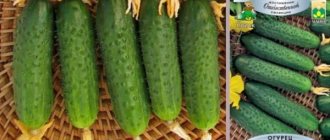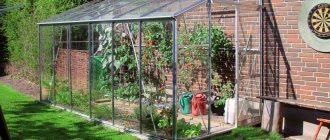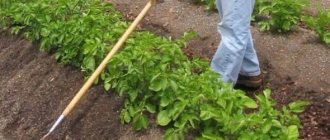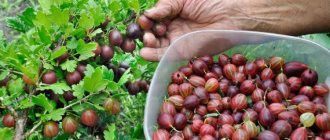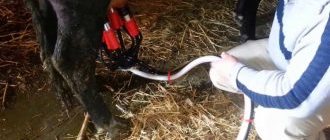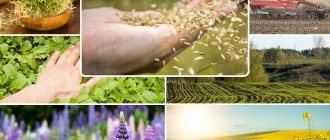What can you grow in an unheated greenhouse in winter?
A permanent greenhouse made of polycarbonate allows you to not interrupt the growing process even in the coldest time.
You need to choose what can be planted in a greenhouse for the winter based on considerations of economic feasibility, personal preferences and ability to properly care for it. It is important to study the needs of the plants, recommendations for reliable operation and possible difficulties. With the right approach and investment of certain funds, it is not difficult to even organize your own business. Advantages and disadvantages of winter planting
For the winter, seeds of frost-resistant crops are planted in open ground, capable of withstanding the harsh climate of the cold period without damage. A positive aspect of winter planting is the shift in the beginning of the growing season to an earlier time, which speeds up the possibility of harvesting by two to three weeks.
The seeds undergo stratification at a low temperature and are hardened, the seedlings are disease-resistant and strong, with powerful roots, and are less damaged by pests. The yield of such plants in a greenhouse in winter is usually much higher.
But there is always a threat of complete or partial death of seedlings if the weather is unstable with prolonged warming, which contributes to their premature development. Insufficient snow cover may not cope with the protective functions. During winter planting, you have to spend more seeds, since their germination rate is lower.
This can be avoided if you sow the necessary crops for seedlings or greens in a greenhouse in the fall. Even without heating the room, plants have a chance to receive some protection from strong temperature changes, flooding with melt water followed by freezing, and strong winds. When there is a sharp cold snap in winter, it is advisable to additionally cover the plants.
Greenhouse crops at different times of the year
In the spring and summer, polycarbonate greenhouses are used for the most capricious southern crops that are unable to ripen in the local climate, as well as for growing planting material for open ground. In winter, you can plant plants that are more adapted to the lack of light and heat, which will allow you to grow vitamin-rich fruits or greens without damage.
Examples of plant selection
What can you plant in a greenhouse for your family in winter? The main vegetables for all-season greenhouses are cucumbers, zucchini, and tomatoes. Eggplants and peppers are more demanding of external conditions and difficult to care for. Not every greenhouse is suitable for growing them. A variety of greens (onions, dill, parsley) are grown en masse in winter, even in unheated rooms.
Unheated underground greenhouse
Before winter, you can plant popular root vegetables in a greenhouse - beets, radishes or carrots, but you should choose the most cold-resistant and early-ripening varieties. It is advisable to fill the greenhouse with several types of plants with similar conditions.
Flower lovers can grow suitable varieties of roses, chrysanthemums, asters, lilies, crocuses and other flowering species. It is also worth sowing vegetable and ornamental crops as seedlings for open ground in free areas so as not to clutter the window sills in the house.
What should a winter greenhouse be like?
The greenhouse must have a strong and stable frame, be located on an elevated area or on the south side of the house (outbuilding). It is advisable to deepen the foundation by about 0.8 m and additionally insulate it from the outside. A greenhouse for winter should be well lit by the sun and have a system of protection against flooding by groundwater and melt water.
In winter, trouble-free heating systems (water, electric or air), ventilation and irrigation (better than drip - saves water consumption) are important. You also cannot do without installing additional lighting devices (preferably LED). It is advisable to use vertical adjustment of the position of the lamps.
In the most severe frosts, the air temperature in the room should not fall below +15 °C, and during most of the time it should be within +20-25 °C.
What to sow in a greenhouse for the winter
Before planting vegetables or other crops in an unheated greenhouse, you need to find out the necessary microclimate parameters to maintain a specific plant, because the temperature in such a room is low. Conditions in a heated greenhouse vary depending on its design and equipment, and the climate of the region. After all, heating devices have a limited resource, which is also affected by the cost of energy.
What can you plant in an unheated greenhouse?
The positive qualities of a greenhouse are the exclusion of the negative effects of atmospheric phenomena (strong winds, precipitation). Additional insulation measures (sealing all cracks, deepening the soil, using reflective screens and dark film) improve conditions in the greenhouse in winter. Biofuel is increasingly being used by constructing warm beds on heated mixtures based on manure or straw
If there are no devices for artificial heating, then the negative temperature in winter, especially in northern areas, does not allow growing any plants. In an unheated greenhouse, various cold-resistant garden crops can successfully overwinter, which in the open ground can freeze, get wet or weaken.
During the cold season, the greenhouse can be used as follows:
- sow parsley, lettuce, celery, early carrots and beets, radishes, which are removed in the spring;
- plant onion sets for seedlings or onions for greens;
- store bulbs of flower crops (hyacinths, crocuses), as well as rhizomes of dahlias and chrysanthemums during the dormant period, followed by their cuttings;
- bring in saffron, iris, and narcissus bulbs in February for forcing flowers;
- place two-year-old plants that are not cold-resistant enough for the winter;
- sow flower and ornamental crops - lily, begonia, gloxinia, coleus;
- sow legumes, corn, and thyme closer to spring for replanting in open areas.
You need to monitor weather conditions and, in the event of a sharp cold snap in winter, protect the plants in the greenhouse using available covering materials.
Planting plants in a heated greenhouse
After harvesting the summer-autumn harvest, thoroughly cleaning the soil from plant residues, applying fertilizing and sanitary work, you should finally decide what is best to plant in the greenhouse in winter. You need to know the upper limit of the temperature that can be stably maintained in the greenhouse. When its value is less than +15 °C, many plants stop developing and may die or drop fruit ovaries.
A heated polycarbonate greenhouse can be used for breeding early-ripening varieties of vegetables (cucumbers, tomatoes), producing seedlings, and year-round growing of herbs or flowers (peonies, roses, dahlias). Installing shelving, using the trellis method or vertical beds will help to rationally use the space.
A more costly and time-consuming, but interesting activity is to plant strawberries for the winter. It is worth trying a convenient method of placing bushes in bags with soil mixture, in pipes or the Dutch layer technology. It is important to stock up on high-quality seedlings that can produce a good harvest, better than remontant varieties.
In a heated room, the soil does not freeze, which contributes to its disinfection from pathogens and various pests. Planting green manure plants (mustard, rye, vetch), which saturate it with useful substances and microelements, loosen and get rid of insects and weeds, will help improve the general condition of the soil.
Growing cucumbers in winter
Growing cucumbers in autumn-winter rotation is not so troublesome and expensive compared to other vegetable crops. They are moderately demanding of temperature and temperature changes, and the yield of high-intensity hybrids, subject to the recommended microclimate parameters, is at least 30-35 kg/m2.
Growing vegetables in winter in a greenhouse
Compared to greens, it is more difficult to grow fruit-bearing plants in a greenhouse in the cold season. This is due to the fact that they need bright light more. But despite this, there are varieties that, if the rules of care are followed, will give good results.
Tomatoes
Tomatoes are a heat-loving crop, but if certain conditions are created, they can also be planted in a greenhouse for the winter. When choosing a variety, choose self-pollinating, early-ripening and cold-resistant varieties. It is also better to choose varieties with small fruits, because... they will ripen faster. Cherry tomatoes are a good choice.
Mini tomatoes grow better in greenhouse conditions than regular varieties. But to harvest a good cherry harvest, you will need to use additional lighting. Daylight hours for tomatoes should be 16 hours, and the air temperature during the flowering period at night should be at least 18 degrees. During the day, the temperature in the greenhouse should be within 25 degrees.
The necessary conditions for growing tomatoes in winter do not differ from those they need to create in summer. Read the article about how to care for tomatoes after planting.
Chilli
Mini peppers grow well not only in a greenhouse, but also indoors on a windowsill. To get a good harvest, it is best to plant cayenne pepper. Caring for them is the same as for cherry tomatoes. The temperature required for good growth of chili peppers is +16-18°C.
In a moderately heated greenhouse, ripening proceeds faster than in an unheated or excessively hot one. Plants need plenty of light and do not tolerate drafts. Watering should be moderate.
cucumbers
In order to plant cucumbers in a greenhouse in winter, you need to choose the right variety. It must be a shade-tolerant, high-yielding, self-pollinating hybrid. Remember that cucumbers are a moisture-loving crop and require regular watering. The water temperature should be approximately the same temperature as the soil (+18 - +20 degrees). The air temperature should not be higher than +25 degrees and fall below +15 degrees, otherwise there is a high risk of infection of the root system with fungi. Read more about caring for cucumbers in a greenhouse in the article.
Microgreen
Microgreens are the same familiar greens, only in miniature form. Miniature greens contain a large concentration of vitamins and microelements, since the plant is only at the beginning of its development. It tastes the same as fully formed sprouts. The most popular microgreens are radishes, basil, arugula, onions, mustard, cilantro, and red cabbage.
To obtain high-quality and healthy sprouts, it is necessary to use nutritious soil. Before planting in the ground, the grains should be soaked. After they begin to germinate, the seeds should be spread evenly on the surface of the soil, and then lightly covered with a thin layer of soil or sand. To harvest the first harvest as quickly as possible, you need to monitor the condition of the soil. The soil should always be moist.
Ginger
You can also grow one of the most vitamin-rich spices in winter - ginger. It is recommended to use a terrarium for this. Its height should be at least 60 cm. Many drainage holes should be made in the container through which excess water will flow out. The optimal daylight hours for ginger are 16 hours a day.
Planting in a greenhouse before winter
Yesterday, October 13, we finally cleaned the greenhouse, removed all the cucumber vines (the tomatoes were pulled out earlier) and the lettuce, which continued to grow well. After this, the entire internal surface was thoroughly washed with a disinfectant solution. All that remains is to carefully dig up the soil with wood ash, which we have stored in abundance.
Read on Dacha6.ru:
Interestingly, in the middle of the week the last 12 greens of the season were collected. They were all small, about the length of an index finger and the same thickness.
Planting our favorite white mustard in mid-October is clearly too late. Then what, should we leave the greenhouse for the winter as is, until the start of the next season? There is a more interesting option!
Planting mustard in a greenhouse in spring. When to sow mustard in a greenhouse in spring?
Why sow mustard in a greenhouse in the spring? When is mustard needed in a greenhouse? Read today's article about when to plant mustard in the spring and how to properly prepare the soil.
When to sow mustard in a greenhouse in spring?
Mustard is a popular green manure, that is, a plant that renews the soil mixture, preparing it for planting other plants. Popular green manures include rye, oats, legumes and, of course, white mustard. It is used for processing open ground and for renewing soil in greenhouses. How to use mustard then? Some are mowed and dug into the ground without waiting for grains to form on the sprouts; the other can be used for growing and, accordingly, producing mustard, homemade preparations or for sale.
When to plant mustard in a greenhouse?
In order to have time to prepare the soil for planting garden crops, mustard must be sown early, giving time for germination, development and soil renewal. It is better to plant mustard seeds in the greenhouse soil in the fall or immediately after fruiting. The same goes for open areas. You can also sow mustard seeds from late March to mid-April in order to be in time for late spring processing.
What does mustard give in a greenhouse in spring:
- Constant feeding.
- Renewal and disinfection.
- Improving the structure.
- Preparation for landing.
- Weed suppression.
Mustard planting dates and development period
When to plant mustard in spring: from March.
How long will it take to germinate: 1 month.
Sowing volumes: 300 grams per hundred square meters.
Renewing the soil mixture with mustard even after growing garden crops is possible until the end of August. During this period, white mustard green manure will renew and loosen the soil, and will also actively suppress germinating weeds. As you know, most weeds are difficult to fight precisely because, having been preserved in the soil mixture, they continue to sprout, despite the planted crops - a confrontation over who will win the victory of white mustard.
How to prepare soil in a greenhouse in the fall
At the end of October - beginning of November, when persistent frosts come to central Russia, some crops can be sown before winter in an unheated polycarbonate greenhouse.
Again, you need to dig up the soil properly, while adding organic (up to 5 kg per 1 m2) and mineral fertilizers (1 tbsp per 1 m2), and ash (1 cup per 1 m2). After digging, carefully level the surface with a garden rake. During the procedure, remove all found plant residues from the soil.
When the preparatory part is completed, it is necessary to make grooves and plant.
Planting in a polycarbonate greenhouse
different crops in a polycarbonate greenhouse vegetables , berries, flowering ones? Growing different types of plants in greenhouses requires knowledge of agrotechnical features. Experienced gardeners even manage to grow crops that are completely incompatible with each other in the same greenhouse. But this is an entire art, which can only be mastered over time, after making many mistakes. If you are interested in what to plant in a polycarbonate greenhouse, we offer several recommendations.
Planting dill, parsley and lettuce before winter
After the radishes, we make grooves for lettuce, parsley and dill. We place them in 0.5 cm increments in a row. The depth of embedding is only 1-2 cm. By analogy, we sprinkle them with soil on top (level them), without additional mulching.
In this state we send the greenhouse into the winter. There is no need to throw snow on top. By the end of April next year you will harvest winter crops
and then you can begin the traditional planting of seedlings of cucumbers, tomatoes and peppers.
© Ilya Vladimirovich
| 2018-10-14 Amateur gardener
What can be planted in a greenhouse after harvesting?
Adding an article to a new collection
When greenhouse plants finally stop bearing fruit, gardeners often simply uproot them and prepare the greenhouse for winter rest. But in vain - before the onset of real cold weather, you can still successfully grow a lot of useful things in an empty place!
We have already talked about using a greenhouse in winter - greens, strawberries, and vegetables can be grown in it even in the coldest months, but, of course, only if you have a well-established heating and lighting system.
However, even if you have an ordinary unheated greenhouse, do not rush to preserve it for the winter immediately after harvesting greenhouse crops for spring and early summer sowing. With sufficient skill and knowledge, a covered structure on your garden plot will allow you to grow another crop in the season in the same beds without installing additional equipment.
Green manure for tomatoes in the greenhouse in the fall. The best green manure for tomatoes in the fall
The composition of green manure for autumn sowing depends on where you plan to grow tomatoes - in a greenhouse or in open ground.
The dates indicated below are relevant for the middle zone. If you live in southern latitudes, they move forward 2 weeks. For cold climates, you need to count 1.5-2 weeks ago from the given dates.
What to sow in a greenhouse before mid-September
Cruciferous green manures - oilseed radish, white mustard, spring rape, spring rapeseed.
All these plants loosen the soil to great depths, saturate it with nitrogen and potassium, and also suppress pathogens of fungal infections. But my favorite is white mustard - it is a real record holder for the speed of green mass gain. She is also super unpretentious.
Legume green manure - annual lupine, peas, spring vetch, seradella.
Legumes are used as green fertilizer when your main goal is to saturate the soil with natural nitrogen.
From this list, I advise you to pay attention to peas and annual lupine. Lupine is especially good in this regard. It not only provides complete nitrogen fertilization, but also inhibits the development of pathogenic bacteria in the soil.
And according to American agronomists, the best green manure for tomatoes is vetch. It has been experimentally proven that growing it in a tomato bed gives an increase in yield of up to 50%!
Phacelia and buckwheat. Of these two crops, it is better to choose phacelia. It works no worse than mustard, and also helps normalize the acidity of the soil in the greenhouse.
What to sow in the greenhouse before the end of October
Spring rape
We usually remove the last tomato plants from the greenhouse in mid-October. At this time, it is already too late to sow spring crops indoors - they will not have time to grow even to 10 centimeters before the onset of cold weather.
In such a situation, winter rye and winter oats help out. Before winter arrives, they manage to emerge and slowly grow until severe frosts.
Cereals are famous for their phytosanitary properties. This is also the best option if you need to thoroughly loosen the greenhouse soil and protect it from erosion processes in the off-season.
What to sow outdoors in September
It is useful to add some lupine or pea seeds to winter green manure cereals.
In open ground, it is good to plant tomatoes the next year after mid-season vegetables - cauliflower, zucchini, cucumbers, asparagus and regular beans, beans. But these crops usually leave the beds no earlier than September, when it is too late to sow most green manure crops.
Until the end of September, winter rye and winter oats can be sown in open ground. In this case, the plants are left in the garden until spring.
If cabbage or pumpkin plants (cucumbers, zucchini, squash) grew in the garden before, I advise you to pre-fill the soil with fertilizers (per square meter):
- compost, humus - ½-1 bucket;
- complex mineral fertilizer - 5-7 grams.
After legumes, only phosphorus and potassium fertilizers are applied at the same rate - 5-7 grams per square.
Crop rotation in a greenhouse
Many people begin harvesting in a greenhouse already in July - it all depends on the selected varieties of tomatoes, eggplants, peppers or cucumbers. So by August, and even more so by September, most gardeners have large areas freed up, on which the hand just reaches out to plant something like that. Plant? Certainly! It is still quite warm outside, the daylight hours are long enough, and some crops with a short ripening period will have time to ripen in place of the harvested ones.
However, do not rush to plant the first early-ripening plants you come across on empty greenhouse beds; remember the requirements of different crops for soil and growing conditions and the rules of crop rotation, the science of competent alternation of plants on a site. It is the observance of these same rules that will help to significantly increase the return from the use of the site without significant investments, improve the health of the soil and allow its resources to be spent more rationally.
What to plant?
Most types of green manure belong to the cruciferous and cereal families. But for certain crops in the greenhouse, certain green manure varieties are suitable. There are also restrictions: you cannot choose green manure and crops that belong to the same family, so as not to transfer diseases. If green fertilizer is used on the site for several seasons in a row, then you cannot plant the same plant; you need to alternate green manure species.
See also
Pros and cons of straw mulching, types and how best to useRead
For tomatoes, peppers and eggplants
For representatives of the nightshade family, legumes, cereals and cruciferous vegetables are good predecessors. You can also sow phacelia, goat's rue, lupine, and buckwheat. Any of these plants can increase the yield of popular garden crops by a third. And when planting seedlings in the soil where green manure previously grew, it will protect it from pests.
After nightshades, it is recommended to sow radish, mustard, and phacelia. Plants will clear the soil of late blight pathogens and fill it with nitrogen.
For cucumbers
Cucumbers have a shallow root system; they take nutrition from the top layer of soil, so it should be the most fertilized. It is permissible to plant almost all common green manure crops under this crop in a greenhouse. From spring and throughout the summer, you can also sow plants between the rows. This will only improve the taste of the cucumbers. It is not recommended to sow rye before the crop. It is believed that it suppresses not only weeds, but also cucumbers.
Expert opinion
Zarechny Maxim Valerievich
Agronomist with 12 years of experience. Our best country expert.
Ask a Question
After greenhouse cucumbers, legumes or vetch-oat mixture are sown. Plants will be able to restore depleted soil and add nitrogen to it.
For other crops
In a greenhouse in the fall, you can sow any green manure if they can sprout and grow 15-20 cm before the arrival of cold weather. If you plan to leave green shoots over the winter, then you can sow winter cereals. You can also mix seeds of different crops and sow at the same time. The benefit from the mixture will be greater, since all plants act on the soil differently and accumulate elements in different proportions. This will allow you to universally prepare the land for different crops.
What to plant in a greenhouse in August and September
As we can see from the previous table, after harvesting in the greenhouse, after almost each of the main crops, you can plant early-ripening and not very demanding onions and garlic, greens, green manure, as well as some root vegetables (for example, radishes). Let's take a closer look at the conditions for growing them in an autumn greenhouse.
Onion garlic
Onions and garlic on a feather are always a fail-safe option if you have empty beds. These crops are unpretentious, cold-resistant, and early in maturity. And if you lightly fertilize the soil in the greenhouse before planting them, the plants will certainly delight you with quick, friendly, vitamin-rich shoots - under good conditions, you will harvest your first harvest in 25-30 days.
To force onions to harvest, they use species with a very short dormant period or without one at all (they are ready for the formation of a new crop immediately after harvesting) - multi-tiered, batun, chives, slug.
Salads, spinach, arugula, chard, rhubarb
Various types of lettuce and spinach, as well as arugula, chard, and rhubarb grow extremely quickly, are not afraid of cool weather, do not require a lot of light from nature, and a lot of care from the gardener. Plantings will only need to be regularly thinned, loosened and watered.
All these leafy greens are harvested by cutting off the large peripheral leaves and leaving the young ones to grow. The main thing is to choose early-ripening varieties that will fully ripen by the end of the second or third week after sowing. That is, with a successful combination of circumstances, some of these crops will have even more than one harvest before the real cold snap.
Radish, radish
Autumn radishes are the next unpretentious find for zealous gardeners. It can easily be grown in a greenhouse after the first harvest. The root crops of some of its early ripening varieties are fully formed within 2-3 weeks after the appearance of the first shoots.
The only requirements for radishes are sufficient lighting and regular watering. Even in the abundance of fertilizing he has no urgent need. Just remember that when growing radishes at any time of the year, you cannot add manure to the soil. In general, any nitrogen fertilizers can contribute to the formation of voids in the middle of the root crop.
Radishes planted in vacated beds (especially after cucumbers) will also feel good and have time to grow well. Moreover, you can plant almost any variety of it in a greenhouse at the beginning of autumn - black Russian radish, daikon (Chinese) radish.
Dill, basil, parsley, coriander, fennel
Various herbs will also be an excellent replacement for the main crops in the greenhouse at the very end of summer and in the first month of autumn. Certain early-ripening varieties of plants such as dill, basil, parsley, coriander or fennel will be ready for consumption within 20-40 days after sowing (especially if they are planted in fertilized loose soil with stratified germinated seeds, watered in time and protected from drafts).
The most capricious crop of the above is parsley. It requires good lighting, moderate watering and a certain thermal regime (not lower than 10°C and not higher than 18°C), otherwise it will turn yellow and wither en masse.
Green manure plants
Planting in a greenhouse after the main crop of green manure is another great option to use the empty space of the beds to benefit.
The fact is that these helper plants with a powerful root system and rapidly developing green mass are biological fertilizers, restoring soil fertility naturally. They are sown either in a free plot in the garden, or in the fall after harvesting the main crops. Before the onset of frost, the lush green mass that has grown 15-25 cm is cut off and buried in the ground without digging it up (this does not apply to winter green manure, which is left to grow until spring). This allows you to enrich the soil with valuable nitrogen, loosens it, inhibits the growth of weeds, and prevents the spread of bacterial and fungal diseases. In addition, you will not have to spend a lot of time caring for the new “tenants” of the greenhouse.
Among the most common green manures are:
- cereals (oats, barley, millet, timothy, ryegrass, fescue, wheatgrass);
- cruciferous vegetables (mustard, rapeseed, rapeseed, oilseed radish);
- legumes (lupine, peas, alfalfa, beans, clover);
- borage (phacelia);
- asteraceae (marigolds), etc.
Which ones are suitable for autumn planting in a greenhouse? Almost everything - in early autumn, legumes, buckwheat, rapeseed, mustard, radish, and rape are sown as green manure; just before winter you can sow radishes, mustard, rapeseed, phacelia, lupine, clover, and winter cereals.
Sowing green manure in autumn in a greenhouse. Which green manures to plant in the greenhouse in the fall
The choice of green manure for greenhouses is quite wide.
You can sow legumes, cruciferous or cereal crops, taking into account their germination time. Mustard, oats, rye and phacelia have proven themselves best as green manures for greenhouses, so we’ll tell you a little more about them. One type of green manure can rarely solve all the problems that have accumulated over the season, so use seed mixtures.
Mustard as green manure in autumn
Before the first cold weather, the mustard in the greenhouse will still have time to grow green mass and at the same time protect the soil from pests and weeds. Sown in early autumn, it does not need to be embedded in the soil; it is enough to just mow it slightly and leave it to rot. You can sow mustard before winter to get early shoots.
How to sow mustard on green manure in the fall
Mustard seeds can be purchased inexpensively by weight. When sowing in early autumn, water the soil well to prevent the seeds from scattering and scatter them evenly over the ground. If the procedure takes place on the eve of winter, you need to plant the seeds to a depth of 2-3 cm and sprinkle with soil.
Oats as green manure in autumn
Oats are a real salvation for infertile soil. Plants will saturate it with nitrogen, phosphorus and potassium, loosen it and improve air exchange. Oats are easy to sow, sprout quickly and require little care. Its above-ground part is not very large, therefore, to obtain the best result, green manure is sown together with vetch, peas or alfalfa. It is best to finish sowing before the first frost. Plant the grains to a depth of 3-4 cm.
In order for oats to grow a sufficient amount of green mass before the onset of cold weather, it is best to sow it in early to mid-September.
Rye as green manure in autumn
Rye is valued for its unpretentiousness and high disinfecting properties. It is best to sow it before winter. But you can do this immediately after harvesting. The plants are unlikely to have time to grow enough green mass, but they will already form a strong root system, which will loosen the soil in the greenhouse and repel nematodes.
Rye is quite aggressive and does not like being in the vicinity of other green manures. This plant perfectly suppresses even the most malicious weeds, for example, thistle. It is better to sow rye in rows to a depth of 3-4 cm.
Green manure in autumn – phacelia
Phacelia is a universal green manure that is unpretentious, fast growing and decorative. The plant is not afraid of drought or cold. After it, any crops will feel comfortable in the garden. Phacelia repels wireworms, aphids and nematodes, suppresses the growth of fungi that cause late blight and root rot.
Despite the fact that phacelia is a fairly popular green manure, not everyone knows when to sow it in the fall. You can do this after harvesting until mid-autumn, so that the above-ground part protects the soil from the cold. Or you can do pre-winter sowing - then the phacelia will sprout in early spring, and you can use it to prepare the soil for planting seedlings. Whenever sowing, it is important not to plant the seeds too deep into the soil. It is enough to scatter them over the surface and lightly loosen the soil with a rake.
Now let’s figure out which green manure is best to sow in the fall in a greenhouse for tomatoes and cucumbers.
Sanitation work in the greenhouse in the fall after harvest
Regardless of the degree of greenhouse automation, it is impossible to harvest crops in such a way as to exclude all kinds of debris. We can talk about old roots, seeds and even pests. The importance of cleaning is that it destroys the breeding ground for all kinds of bacteria, bugs and various infections.
At the initial stage, you should carefully examine every centimeter of soil, removing all plant debris.
After this, you need to remove the soil 5-7 cm deep. As a rule, this layer in most cases contains microscopic particles of the old harvest.
The further procedure is as follows:
- Removing existing larvae - it is enough to miss only 1-2 insects to grow a good harvest;
- If we are talking about a small greenhouse, then it is strongly recommended to sift the soil, otherwise the cockchafer larvae cannot be destroyed;
- If the greenhouse occupies an impressive area, you should use drugs to prevent the appearance of pests;
- It is necessary to treat the walls and ceiling of the building with disinfectant solutions - often pathogenic microorganisms can hide there for the winter;
- Burnt sulfur soil is treated from 1 to 2 times, depending on the area of the structure;
- The minimum recommended concentration is 100 g / 1 m2;
- All of the above manipulations must be carried out only before the onset of frost, otherwise everything done will not have much effect.
The soil, walls and ceiling of the greenhouse should always be under the constant attention of the gardener. It is enough to miss just a few centimeters for growing even resistant crops to become a very problematic task.
Greenhouse in autumn (video)
The success of the spring harvest begins in the fall. First, a thorough cleaning is carried out inside and outside the greenhouse. After this, the soil and walls should be treated with a special solution that reduces the likelihood of pathogenic microorganisms appearing. Do not forget about planting special crops - green manure, which have a beneficial effect on the soil.
- Author: admin
Rate this article:
- 5
- 4
- 3
- 2
- 1
(0 votes, average: 0 out of 5)
Share with your friends!
What is mustard used for in a greenhouse in the fall?
From school, citizens know about the need for a cultural change. This is done after a certain period of time so that the soil does not completely lose its biochemical characteristics. In addition, you need to remember about natural fertilizers. We are talking about green manure that adds essential nutrients to the soil.
One of the most famous representatives of this class is mustard, which must be planted in the fall in a greenhouse to prepare the soil.
On the one hand, the soil receives a large amount of organic matter, and, on the other hand, powerful treatment against bacteria and pests occurs. Here it is important to focus on the fact that the future harvest will not receive even 1 mg of environmentally unsafe substances.
In order for green manure to have a positive impact, a number of rules must be followed:
- It is recommended to plant the crop before the onset of severe cold;
- The minimum permissible temperature must be no less than +5C;
- Operation at lower t values is allowed if the greenhouse has a heating system - a “warm bed”;
- Gardeners should remember that mustard does not require high temperatures, so installing additional heating systems is not required;
- If you plan to grow radishes or cabbage in the future, then you need to choose a different type of green manure.
Using natural products to protect and fertilize the soil allows you to reduce the waste of time and effort. Green manures are agricultural crops that can be used in spring and autumn. One of the most famous representatives of this class is mustard. The only thing you must always remember is that this crop is not compatible with a number of vegetables, for example, radishes and cabbage.
Why plant green manure in a greenhouse?
By sowing the soil in the greenhouse with green manure, we launch a full crop rotation.
For example, we grew tomatoes - after harvesting the main harvest we sowed phacelia - in the middle of autumn we mowed the phacelia and sowed mustard - in the spring before planting the seedlings we managed to grow and mow the vetch - and again with a clear conscience we plant tomatoes in the same bed. Babble! But that's not all. Green manure plants are mostly multifunctional. What don’t they do! Here are the main arguments in their favor:
- if green manure is not dug up, its roots form a natural soil structure, improving soil permeability to moisture and air;
- dense plantings suppress weeds;
- are a natural organic fertilizer, restore the fertile layer and replenish the lack of mineral salts;
- many green manures release substances into the soil that repel pests;
- inhibit pathogenic microorganisms by creating good conditions for the development of beneficial microflora and fauna.
Green manure is sown both in spring and autumn. It is no coincidence that today we are focusing on autumn planting. Sideration after harvest, among other things, performs a protective function. Vegetation cover retains moisture in the soil in the beds, helping them not to freeze or dry out during the winter.
Almost any plant can be a green manure, even weeds, if you manage to cut them off before flowering. But some plants seem to be specially created for this purpose: they grow by leaps and bounds, produce juicy greens and do not require special care.
Tips for beginners: what to plant in a greenhouse in the fall
Before active agricultural work begins, it is necessary to carefully study the greenhouse. If it has been used for a long time, then future crops are selected taking into account structural parameters, soil acidity, and so on. Greater freedom of action is allowed when the greenhouse is at the design stage. This means that the structure is being built taking into account the existing plans.
The following recommendations from an experienced gardener will help simplify the selection procedure:
- You can grow parsley in a greenhouse, but you must provide the minimum required light and heat conditions. If the soil is not fertile enough, adding nutrients will help correct the situation. You can fertilize with manure or nitrogen-containing substances.
- In order for sorrel planting to be successful, you need to use rhizomes that are 3 to 4 years old. Planting is done with an interval of 4 cm between the bushes.
- If you plan to grow strawberries, then in this case you need to install a polycarbonate greenhouse.
The ripening of seedlings in the autumn-winter period requires increased attention to the level of humidity, temperature and the presence of nutrients in the soil. Properly organized preparation will help you avoid many problems. For example, you need to apply fertilizer and make sure there is a sufficient concentration of minimum substances in the soil. Among the most common crops for autumn sowing are sorrel, strawberries and parsley.
Specifics of growing in a polycarbonate greenhouse
Berries, flowers and vegetables grow well in a polycarbonate greenhouse if you plant suitable crops and provide proper care for each species.
Experts recommend setting up no more than three beds: this will provide all plants with enough light and air, and will also make it easier to care for the vegetation. At the same time, you can plant tall species in the middle bed, and choose low-growing crops for planting in a polycarbonate greenhouse on the side beds: greens, carrots, peppers, beets, pumpkins, melons, watermelons, and other melons.
Another option is to place seedlings of different plants in a checkerboard pattern, leaving 55-65 centimeters between the “squares”. It looks unusual.
Considering what can be grown in a polycarbonate greenhouse, experts confirm the possibility of growing different species together. But at the same time they remind you that for this you will have to try and take into account many nuances. Therefore, it is better for novice gardeners to first try planting only one crop, maximum two or three.
It is important to regularly ventilate the greenhouse, otherwise the vegetation will suffocate. But it is important to ensure that crops that do not like drafts - pumpkin, zucchini, cucumbers - do not suffer.
Expert advice! Experts advise placing containers of water in the greenhouse. This will keep you warm longer after the sun has set. The liquid will heat up during the day and release the accumulated heat to the plants at night. For the winter, the structure can be disassembled, removing the polycarbonate into a room under the roof to protect the material from damage as a result of heavy snowfalls.
Working on mistakes: growing in a greenhouse in the fall
Once a gardener has determined what crops they plan to plant, they need to do the following. First, you need to fertilize the soil in accordance with the characteristics of the seedlings. If some species require mineral fertilizing, then others require nitrogen-containing fertilizing.
At the next stage, the summer resident turns his attention to the potential amount of the future harvest.
Some crops develop quite quickly in the presence of favorable conditions, so it is worth foreseeing this nuance in advance. Otherwise, cleaning the greenhouse will be a complete punishment.
In addition to this, there are other significant recommendations:
- You shouldn’t dig up the beds too often, otherwise the nutrients will be distributed unevenly;
- If we are talking about a traditional and not a smart greenhouse, it is necessary to check the t and the degree of soil moisture every 24 hours;
- Crops should not be watered too often, otherwise sudden frosts or prolonged rains will activate the rotting process.
